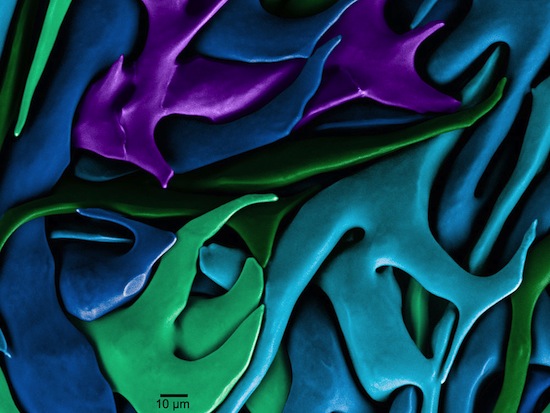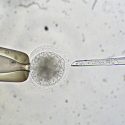UW–Madison physicist wins science image challenge

The forming end of a sea urchin tooth is shown as imaged with a scanning electron microscope and false-colored. While it is not apparent from their intricate and rounded shape, these are single-crystals of calcite, which fill space, resist fracture, and make the tooth so hard and tough that it can grind rocks.
Close your eyes and picture an ocean reef: vivid violet, cool blue and tropical green intertwining in gentle curves and delicate edges. And that’s just the urchin teeth.
“We take many images of sea urchin teeth in our work,” says Pupa Gilbert, a UW–Madison physics professor. “They are not at all what you would expect.”

Gilbert
One of Gilbert’s images proved so remarkable it earned top honors in the 2012 International Science & Engineering Visualization Challenge sponsored by the National Science Foundation and the journal Science, which announced winners today.
Gilbert studies urchins’ ability to gnaw holes in rock to make hiding places in a dangerous ocean environment.
“The calcite crystals that make up their teeth don’t look like calcite crystals usually do, with flat surfaces and sharp edges,” she says. “These images show how the calcite crystals grow and fill space, so that the final tooth can grind rock.”
Sea urchin teeth are essentially self-sharpening, a trick that human toolmakers may someday incorporate into cutting edges that never need honing.
“The story is about evolution, form, and function: biological organisms have a remarkable ability to use natural resources in effective but surprising ways,” according to Gilbert’s submission to the Visualization Challenge. “This particular image provides a new, fresh, surprising and beautiful example.”
To create the picture, which also won the UW–Madison WhyFiles Cool Science Image Contest in 2012, Gilbert painstakingly colored a grayscale image to see the individual calcite crystals instantaneously, despite their complex intertwined shapes. The awards make her computer-graphics passion even more worthwhile, she says.
“This is a prestigious award,” Gilbert says. “The panel of judges is a very impressive, internationally-known group, and I’m honored they appreciated our image.”
Tags: arts, biosciences, physics



